Service CADILLAC DEVILLE 1998 7.G Workshop Manual
[x] Cancel search | Manufacturer: CADILLAC, Model Year: 1998, Model line: DEVILLE, Model: CADILLAC DEVILLE 1998 7.GPages: 386, PDF Size: 22.36 MB
Page 317 of 386
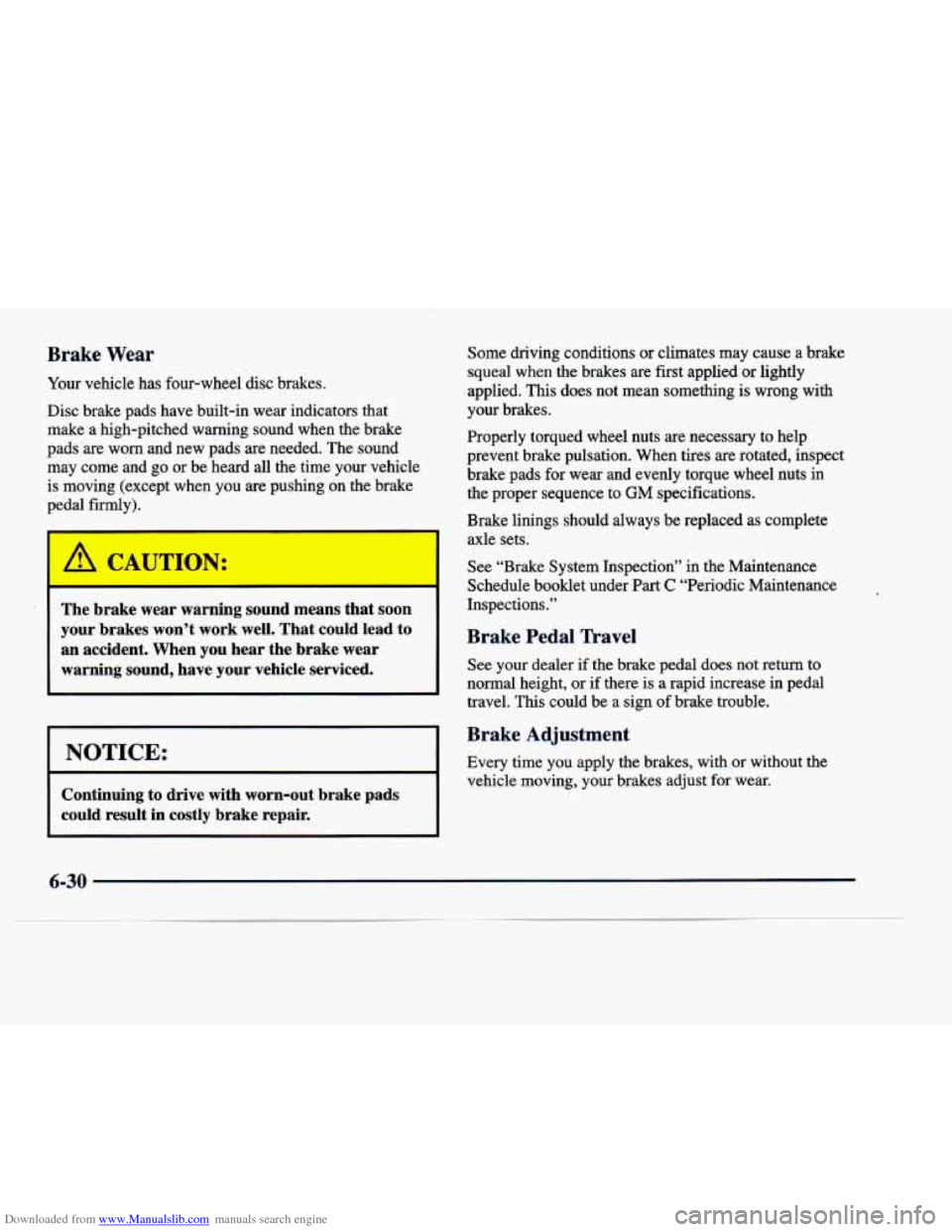
Downloaded from www.Manualslib.com manuals search engine Brake Wear
Your vehicle has four-wheel disc brakes.
Disc brake pads have built-in wear indicators that
make a high-pitched warning sound when the brake
pads’are worn and new pads are needed.
The sound
may come and go or be heard all
the time your vehicle
is moving (except when you are pushing on the brake
pedal firmly).
r
The brake wear warning sound means that soon
your brakes won’t work well. That could lead to
an accident. When you hear the brake wear
warning sound, have your vehicle serviced.
NOTICE:
Continuing to drive with worn-out brake pads
could result in costly brake repair.
Some driving conditions or climates may cause a brake
squeal when the brakes are first applied or lightly
applied. This does not mean something is wrong with
your brakes.
Properly torqued wheel nuts are necessary to help
prevent brake pulsation. When tires
are rotated, inspect
brake pads for wear and evenly torque wheel nuts in
the proper sequence to
GM specifications.
Brake linings should always be replaced as complete axle sets.
See “Brake System Inspection” in the Maintenance
Schedule booklet under Part
C “Periodic Maintenance
Inspections.”
Brake Pedal Travel
See your dealer if the brake pedal does not return to
normal height, or
if there is a rapid increase in pedal
travel. This could be a sign of brake trouble.
Brake Adjustment
Every time you apply the brakes, with or without the
vehicle moving, your brakes adjust for wear.
6-30
Page 319 of 386

Downloaded from www.Manualslib.com manuals search engine Bulb Replacer3
For any bulb changing procedure not listed in this
section, contact
your dealer's service department.
Hnlogen Bulbs
A CAUdC J:
Halogen bulbs have pressurized gas inside and
can burst if
you drop or scratch the bulb. You or
others could
be injured. Be sure to read and
follow
the instructions on the bulb package.
Headlamps
A
A
A
1. To access the headlamps, lift the cover as shown.
6-32
Page 328 of 386
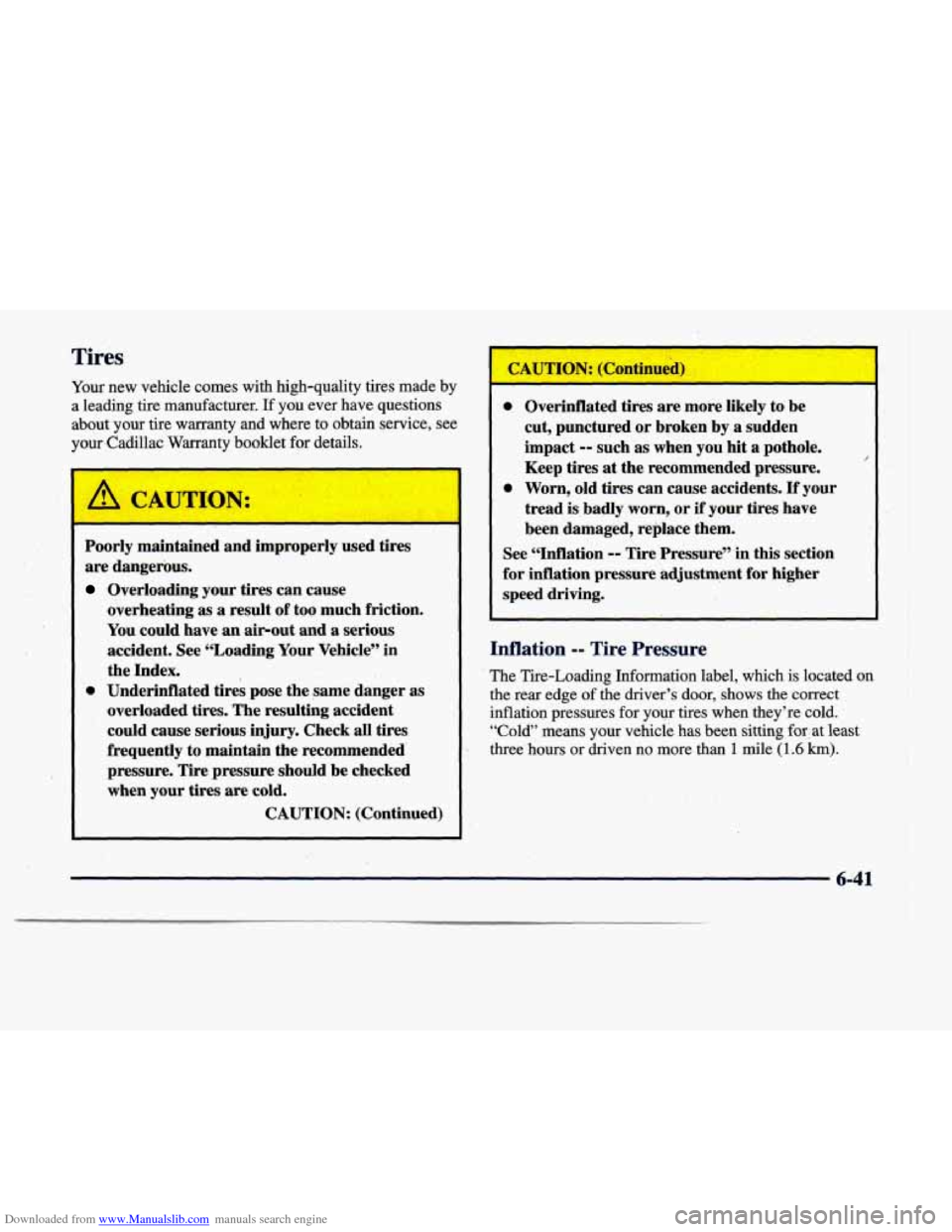
Downloaded from www.Manualslib.com manuals search engine Tires
Your ~ew vehicle comes with high-quality tires made by
a leading tire manufacturer. If you ever have questions
about your tire warranty and where ,to obtain service, see
your-Cadillac Warranty booklet for details.
I-
A CAUTION:
L
Poorly maintained and improperly used tires
are dangerous.
Overloading your tires can cause
overheating as
a result of too much friction.
You could have an air-out and a serious
accident. See “Loading Your Vehicle” in the Index.
‘0 Underinflated tires pose the same danger as
overloaded tires. The resultihg accident
could cause serious injury. Check all tires
frequently to maintain the recommended’
pressure. Tire pressure should be checked when
your tires are cold.
CAUTION: (Continued) CAUTION:
(Continued)
0 Overinflated tires are more likely to be
cut, punctured or broken by
a sudden
impact
-- such las when you hit a pothole.
Keep tires at the recommended pressure.
0 Worn, old tires can cause accidents. If your
tread is badly worn, or
if your tires have
been damaged, replace them.
See “Inflation
-- Tire Pressure’’ in this section
for .inflation pressure adjustment for higher
speed driving.
Inflation -- Tire Pressure
The Tire-Loading Information label, which is located on
the rear edge of the driver’s door, shows the correct
inflatiop pressures for your tires when they’re cold.
“Cold” means your vehicle has been sitting for, at least.
three’ hours or driven no more than
1 mile (1.6 km).
6-41
I -. ..
Page 330 of 386
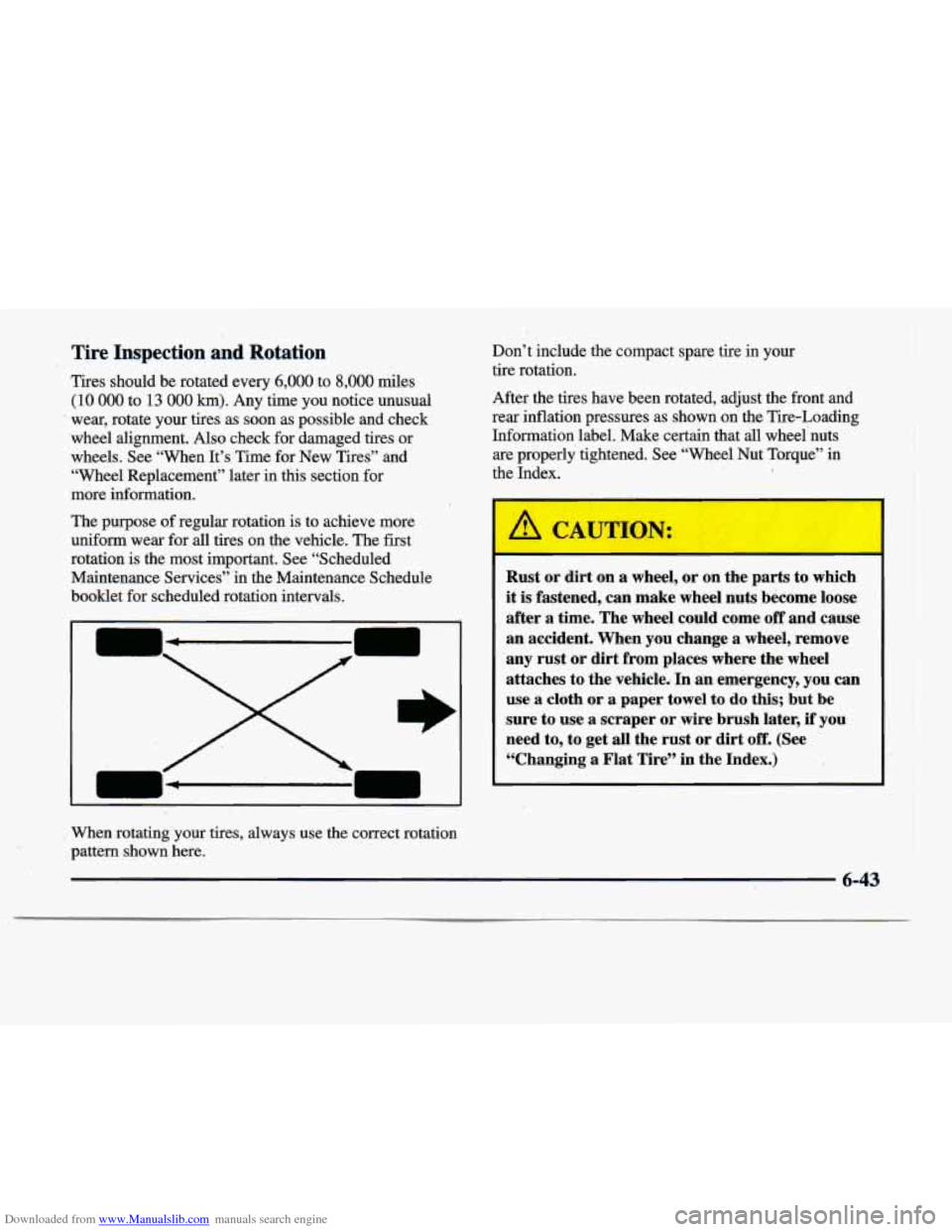
Downloaded from www.Manualslib.com manuals search engine Tire Inspection and Rotation
Tires should be rotated every 6,000 to 8,000 rriiles
(10 000 to 13 000 krn). Any time you notice unusual
. wear, rotate your tires as soon as possible and check
wheel alignment.
Also check for damaged tires or
wheels. See “When It’s Time for New Tires” and
“Wheel Replacement” later
in this section for
more information.
The purpose of regular rotation
is to achieve more
uniform wear for
all tires on the vehicle. The first
rotation
is the most important. See “Scheduled
Maintenance Services” in the Maintenance Schedule
booklet for scheduled rotation intervals.
When rotating your tires, always use the correct rotation
pattern shown here. Don’t include the compact spare tire
in your
tire rotation.
After the tires have been rotated, adjust the front and
rear inflation pressures as shown on the Tire-Loading
Information label. Make certain that
all wheel nuts
are properly tightened. See “Wheel Nut Torqoe” in
the Index.
Rust or dirt on a wheel, or on the parts to which
it is fastened, can make wheel nuts become loose
after a time. The wheel could come
off and cause
an accident. When you change
a wheel, remove
any rust
or dirt from places where the wheel
attaches to the vehicle.
In an emergency, you can
use
a cloth or a paper towel to do this; but be
sure to use a scraper or wire brush later,
if you
need to, to get all the rust or dirt
off. (See ’ .
“Changing a Flat Tire” in the Index.)
6-43
Page 331 of 386
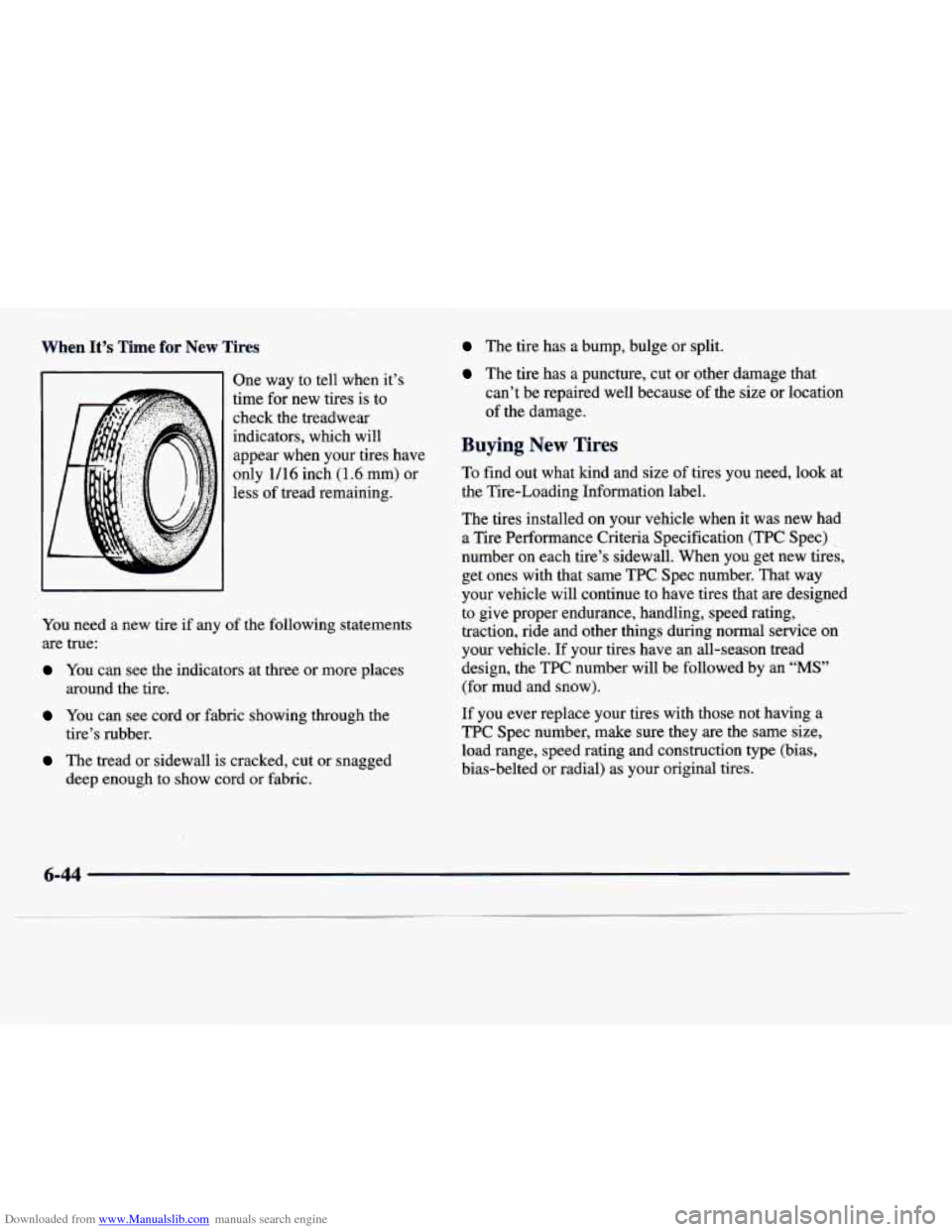
Downloaded from www.Manualslib.com manuals search engine When It’s Time for New Tires
One way to tell when it’s
time for new tires is to
check the treadwear
indicators, which will
appear when your tires have
only
1/16 inch (1.6 mm) or
less
of tread remaining.
You need a new tire
if any of the following statements
are true:
You can see the indicators at three or more places
You can see cord or fabric showing through the
The tread or sidewall is cracked, cut or snaggea
around the tire.
tire’s rubber. deep enough to show cord or fabric.
The tire has a bump, bulge or split.
The tire has a puncture, cut or other damage that
can’t be repaired well because
of the size or location
of the damage.
Buying New Tires
To find out what kind and size of tires you need, look at
the Tire-Loading Information label.
The tires installed on your vehicle when it was new had
a Tire Performance Criteria Specification (TPC Spec)
number on each tire’s sidewall. When you get new tires, get ones with that same TPC Spec number. That way
your vehicle will continue to have tires that are designed
to give proper endurance, handling, speed rating, traction, ride and other things during normal service on
your vehicle. If your tires have an all-season tread
design, the TPC number will be followed by an
“MS”
(for mud and snow).
If you ever replace your tires with those not having a
TPC Spec number, make sure they are the same size,
load range, speed rating and construction type (bias,
bias-belted or radial) as your original tires.
6-44
Page 333 of 386
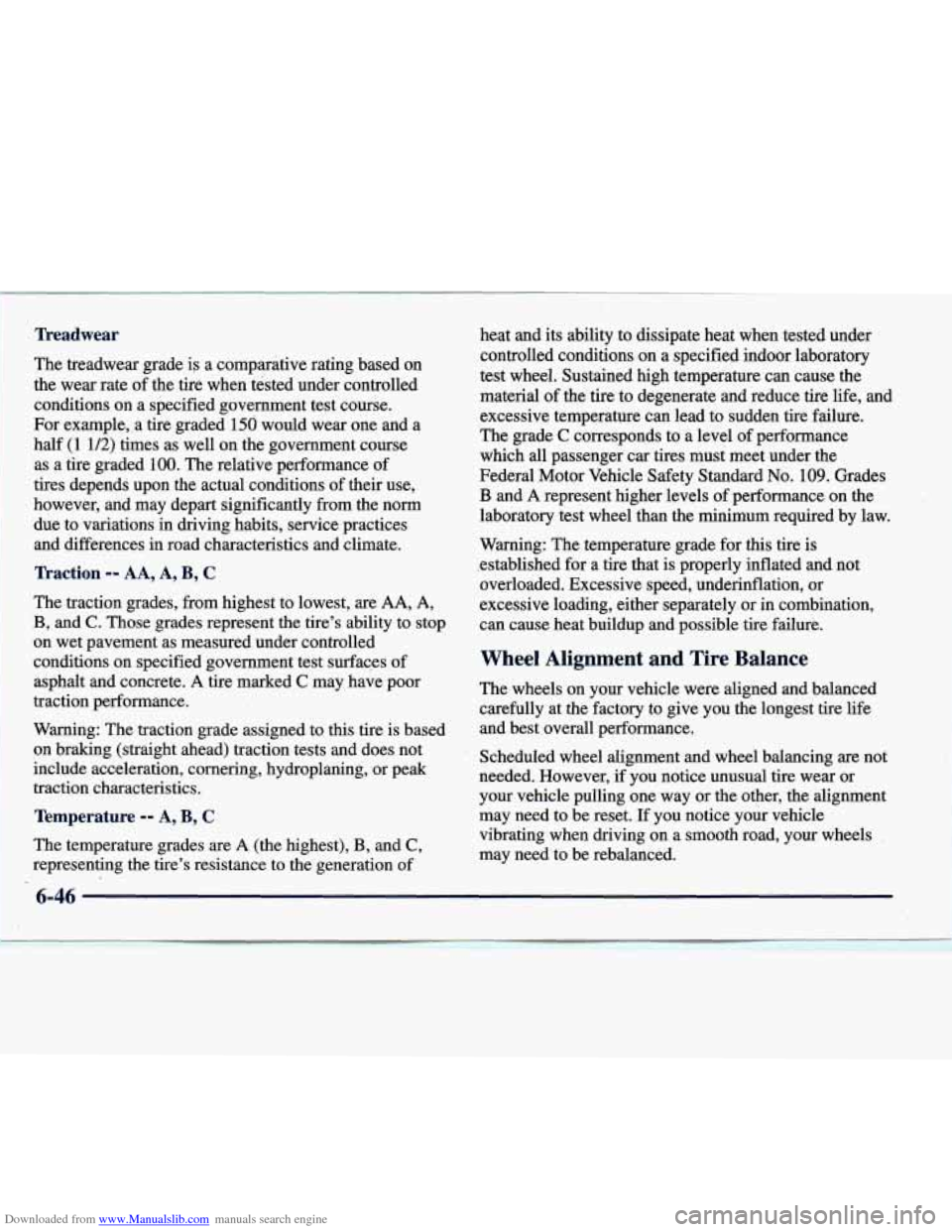
Downloaded from www.Manualslib.com manuals search engine ~ ~~~~~~ ~ ____ ~~ ~~ ~~
~~~
Treadwear
The treadwear grade is a comparative rating based on
the wear rate of the tire when tested under controlled
conditions on a specified government test course.
For example,, a tire graded
150 would wear one and a
half
(1 1/2) times as' well on the governmefit course
as a tire graded
100. The relative performance of
tires depends upon the actual conditions of their use,
however, and may depart significantly from the norm
due to variations in driving habits, service practices
and differences in road characteristics and climate.
Traction -- AA, A, B, C
The traction grades, from highest to lowest, are AA, A,
B, and C. Those grades represent the tire's ability to stop
on wet pavement as measured under controlled
1 conditions on specified government test surfaces of
asphalt and concrete.
A tire marked C may have poor
I traction performance.
.~ ~~~~~ ~ ~~~~~ ~
heat and its ability to dissipate heat when tested under
controlled conditions on a specified indoor laboratory
test wheel. Sustained high temperature can cause the
material
of the tire to degenerate and reduce tire life, and
excessive temperature can lead to sudden tire failure.
The grade
C corresponds to a level of performance
which all passenger car tires must meet under the
Federal Motor Vehicle Safety Standard
No. 109. Grades
B and A represent higher levels of performance on the
laboratory test wheel than the minimum required by law.
Warning: The temperature grade for this tire is
,established for a tire that is properly inflated and not overloaded. Excessive speed, underinflation, or
excessive loading, either separately or in combination,
can cause heat buildup and possible tire failure.
Wheel Alignment and Tire Balance
The wheels on your vehicle were aligned and balanced carefully at the factory to give you the longest tire life
and best overall performance.
Scheduled wheel alignment and wheel balancing are not
needed. However, if you notice unusual tire wear or
your vehicle pulling one way or the other, the alignment
may need to be reset. If you notice your vehicle
vibrating when driving on a smooth road, your wheels
may need to be rebalanced.
1 Warning: The traction grade assigned to this tire is based
on braking (straight ahead) traction tests and does not
include acceleration, cornering, hydroplaning, 'or peak
traction characteristics.
Temperature -- A, B, C
The temperature grades are A (the highest), B, and C,
representing the tire's resistance to the generation of
6-46
~ -~ ~ . ~- ~- ~ - ~ __ __ ~. ~- . ~ ~ .~~ . - ~~
Page 342 of 386
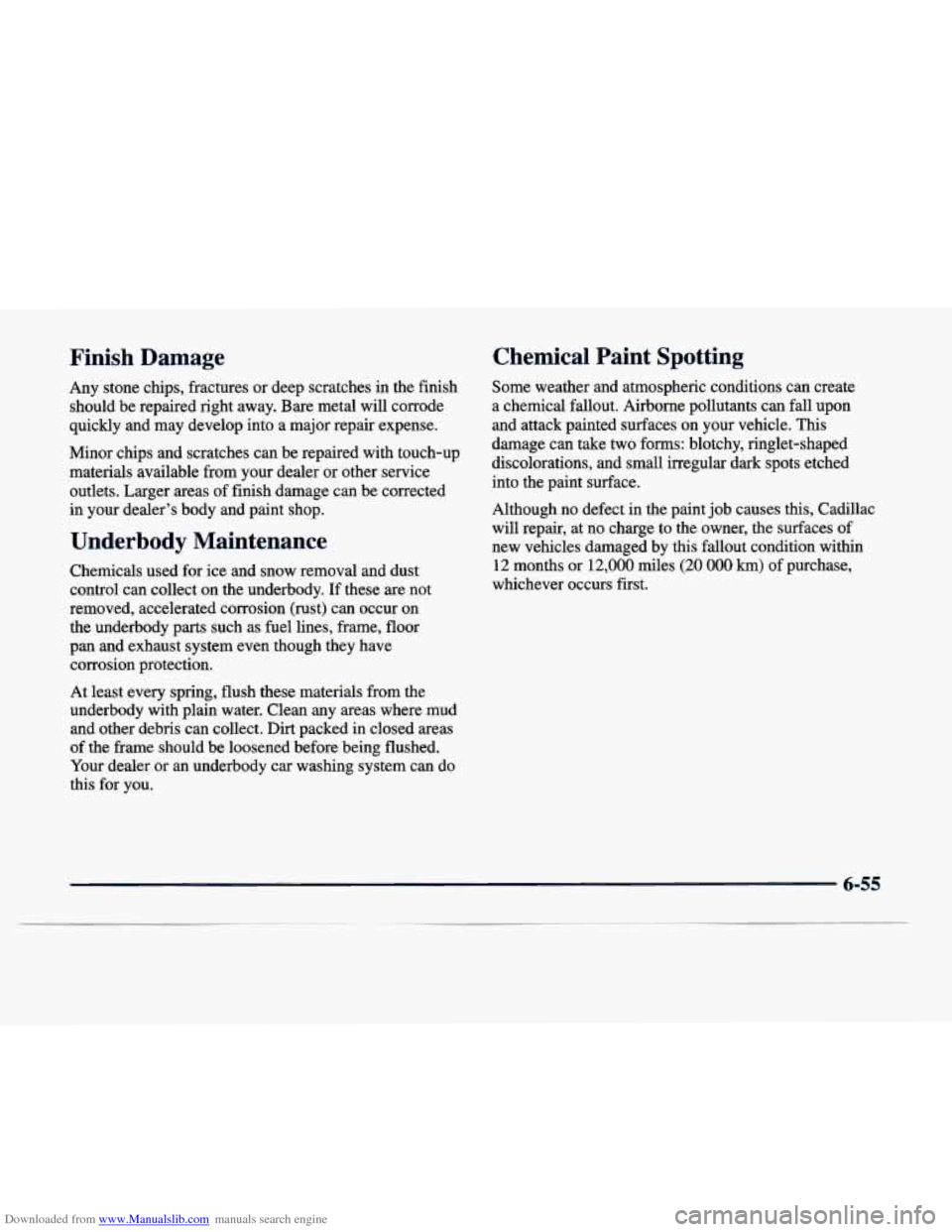
Downloaded from www.Manualslib.com manuals search engine Fink lamage Chemical Paint Spotting
Any
stone chips, fractures or deep scratches in the finish
should be repaired right away. Bare metal will corrode
quickly and may develop into a major repair expense.
Minor chips and scratches can be repaired with touch-up
materials available from your dealer or other service
outlets. Larger areas of finish damage can be corrected
in your dealer’s body and paint shop.
Underbody Maintenance
Chemicals used for ice and snow removal and dust
control can collect on the underbody. If these are not
removed, accelerated corrosion (rust) can occur on
the underbody parts such as fuel lines, frame, floor
pan and exhaust system even though they have
corrosion protection.
At least every spring, flush these materials from the
underbody with plain water. Clean any areas where mud
and other debris can collect. Dirt packed in closed areas
of the frame should be loosened before being flushed.
Your dealer or an underbody car washing system can do
this for you. Some weather and atmospheric conditions
can create
a chemical fallout. Airborne pollutants can fall upon
and attack painted surfaces on your vehicle. This
damage can take two forms: blotchy, ringlet-shaped
discolorations, and small irregular dark spots etched
into the paint surface.
Although no defect in the paint job causes this, Cadillac
will repair, at no charge to the owner, the surfaces of
new vehicles damaged by this fallout condition within
12 months or 12,000 miles (20 000 krn) of purchase,
whichever occurs first.
Page 344 of 386
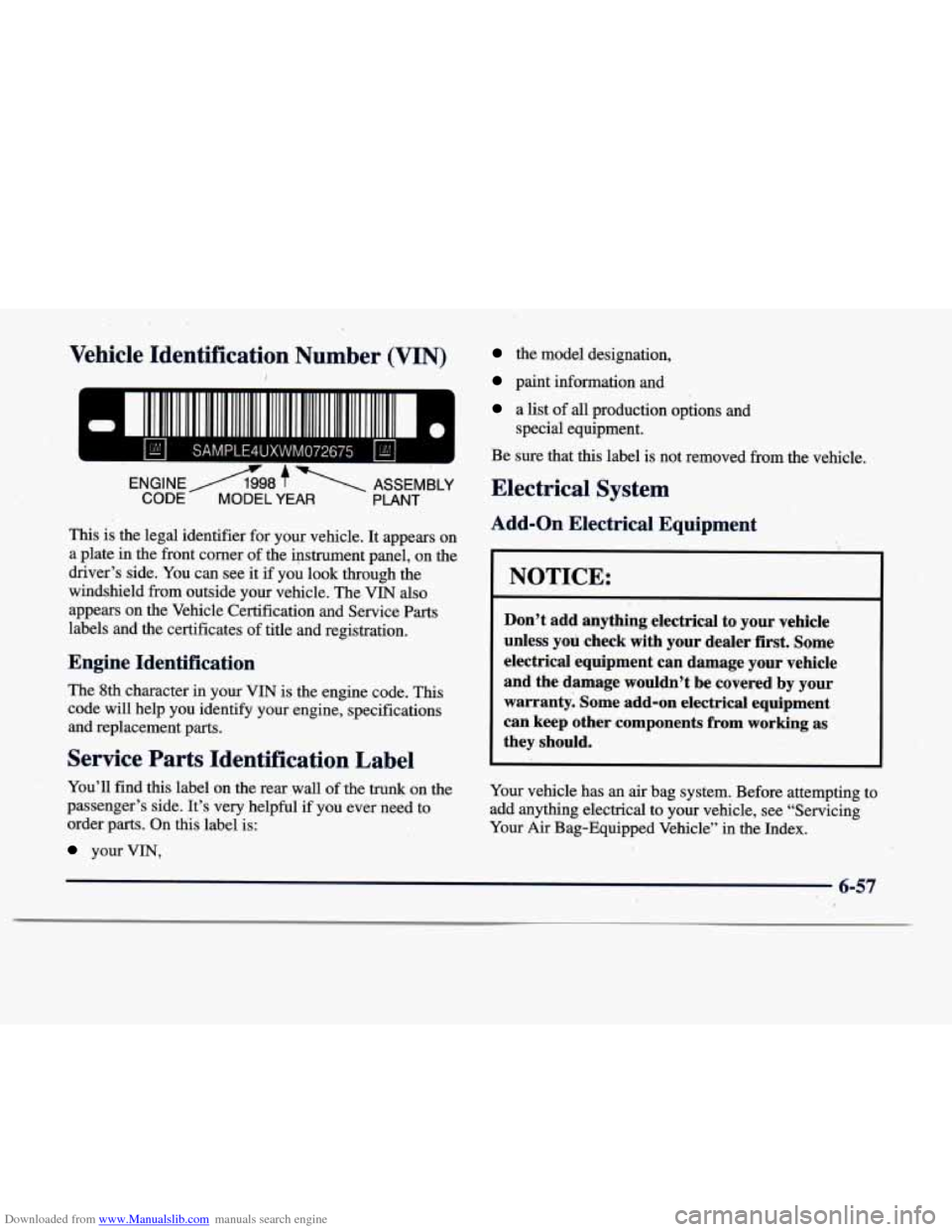
Downloaded from www.Manualslib.com manuals search engine Vehicle Identification Number (VIN)
/
This is the legal identifier for your vehicle. It appears on
a plate in the frmt corner
of the iptrument panel, on the
driver’s side. You can see
it if you look through the
windshield from outside your vehicle. The VIN also
appears on the Vehicle Certification and Service
Parts
labels and the certificates of title and registration.
Engine Identification
The’Sth character in your VIN is the engine code. This
code will help you identify your engine, specifications
and replacement
parts.
Service Parts Identification Label
You’ll find this label on the rear wall of the trunk on the
passenger’s side. It’s
very helpful if you ever need to
order parts. On
this label is:
your VIN,
the model designation,
paint information and
a list of all production options and
special equipment.
Be sure that
this label is not removed from the vehicle.
Electrical System
Add-on Electrical Equipment
I I
I
NOTICE:
Don’t add anything electrical to your vehicle
unless you check with your dealer
first. Some
electrical equipment can damage your vehicle
and the damage wouldn’t be covered by your
warrant$ Some add-on electrical equipment
can keep other.components from working
as
they should.
Your vehicle has an air bag system. Before attempting to
add anything electrical to your vehicle, see “Servicing
Your
Air Bag-Equipped Vehicle” in the Index.
6-57
Page 345 of 386
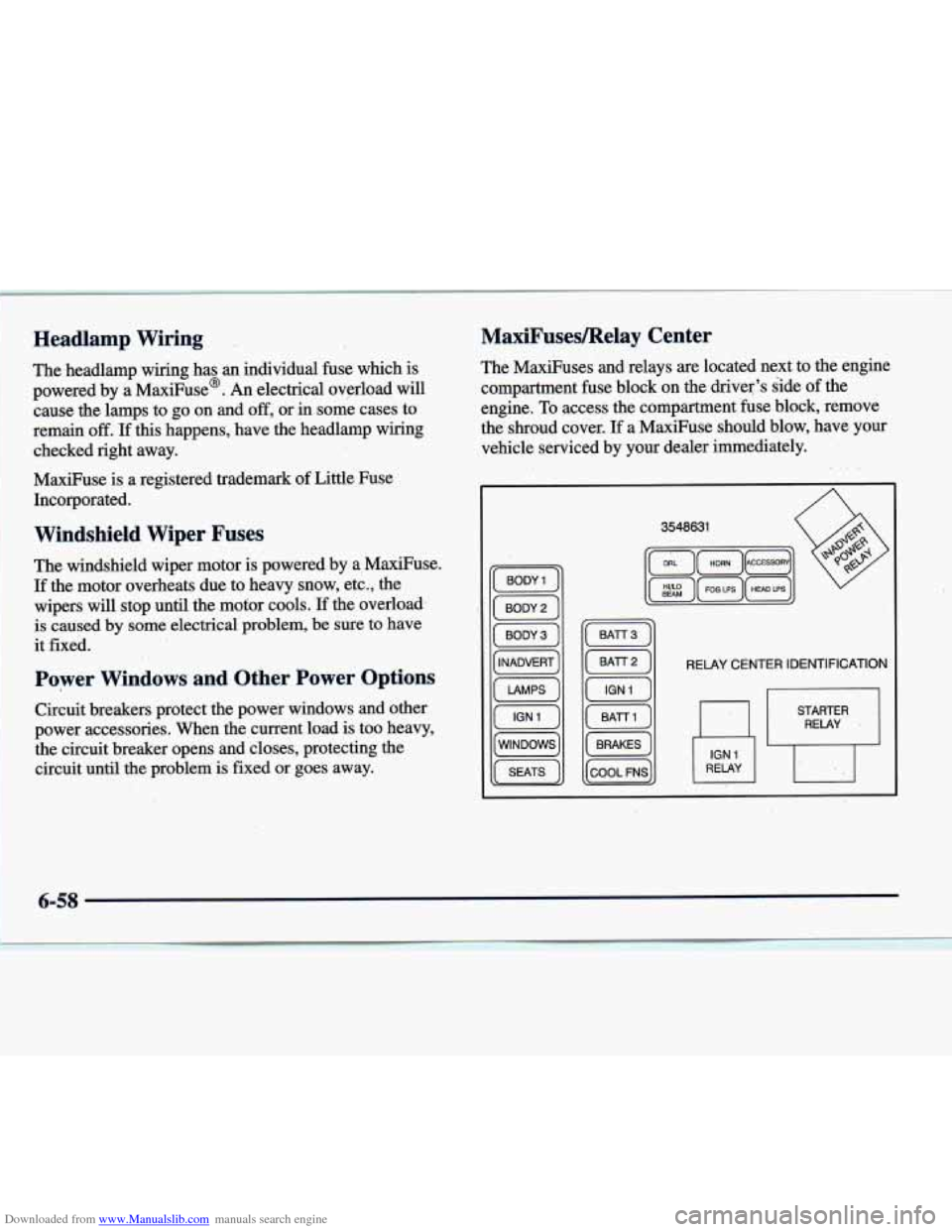
Downloaded from www.Manualslib.com manuals search engine Headlamp Wiring
The headlamp wiring has an individual fuse which is
powered by a MaxiFuse?
An electrical overload will
cause the lamps to go on and
off, or in some cases to
remain
off. If this happens, have the headlamp wiring
checked right away.
MaxiFuse
is a registered trademark of Little Fuse ,
Incorporated.
Windshield Wiper Fuses
The windshield wiper motor is powered by a MaxiFuse.
If the motor overheats due to heavy snow, etc., the
wipers will stop until the motor cools.
If the overload,
is caused by some electrical problem, be sure to have
it fmed.
Power Windows and Other Power Options
Circuit breakers protect the power windows and other
power accessories. When the current load
is too heavy,
the cifcuit breaker opens and closes, protecting the circuit until the problem
is fixed or goes away.
MaxiFusesLRelay Center
The MaxiFuses and relays are located next to the engine
compartment fuse b1oc.k on the driver’s side
of the
engine.
To access the compartment fuse block, remove
the shroud cover.
If a MaxiFuse should blow, have your
vehicle serviced by your dealer immediately.
1GEi-j
(BODYPI
(BODY3)
[-I
(LAMPS)
(7)
[iGGG)
[sEATs]
IGN1 J
(F)
(BRAKESJ
[CooLS-l
p, RELAY
Q
STARTER
Page 356 of 386

Downloaded from www.Manualslib.com manuals search engine .e -A
Section 7 Customer Assistance Information
Here you will find out how to contact Cadillac if you need assistance. This section also tells you how to obtain service
publications and how to report any safety defects.
7-2
7-4
7-5
7-7
7-8
7-9
7-1
1
Customer Satisfaction Procedure
Customer Assistance for Text Telephone
(TTY) Users
Roadside Service
Roadside Service for the Hearing or
Speech Impaired
Gold Key Courtesy Transportation
Transportation Options GM Participation in an Alternative Dispute
Resolution Program
7- 12
7- 12
7- 13
7- 13
7-13
Warranty Information Reporting Safety Defects to the United
States Government
Reporting Safety Defects to the
Canadian Government
Reporting Safety Defects to
General Motors
Ordering Service and Owner Publications
in Canada